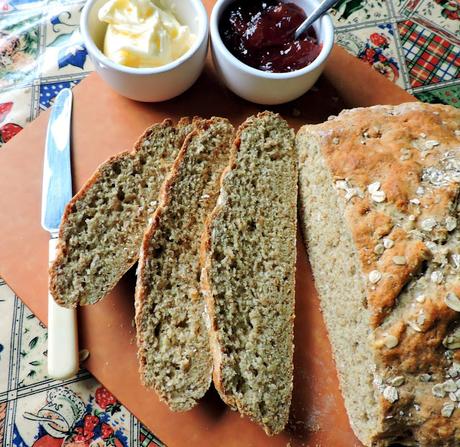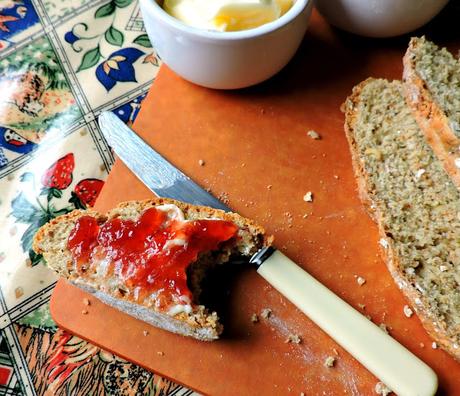 Traditional Irish Soda Bread. There is no better way to celebrate Saint Patrick's Day than to treat your family to some of the traditional dishes of Ireland! You can't get more Irish than Soda Bread, and this traditional Irish Soda Bread recipe is one of the best.
Traditional Irish Soda Bread. There is no better way to celebrate Saint Patrick's Day than to treat your family to some of the traditional dishes of Ireland! You can't get more Irish than Soda Bread, and this traditional Irish Soda Bread recipe is one of the best. As they say, "The proof is in the eating," and this one eats very well, if I don't say so myself!
 The history of this Irish soda bread is interesting to say the least! I was completely blown away by what I discovered! Whilst soda bread is most often attributed to the Irish, it was actually first created by the North American Indigenous peoples.
The history of this Irish soda bread is interesting to say the least! I was completely blown away by what I discovered! Whilst soda bread is most often attributed to the Irish, it was actually first created by the North American Indigenous peoples. They were the first people known to have used pearl ash to leaven their breads without yeast. Pearl ash is the residue, or a natural form of soda formed from the ashes of wood fires.
The Irish later discovered the recipe and replicated the Native North American process. It may seem like an ancient Irish recipe, but it really only came to Ireland in the 1830's when bicarbonate of soda/baking soda was first introduced to the country.
You can read more about that here. Trust me, I don't make this stuff up!
 Whatever Irish Soda Bread history is, one thing for certain remains. It is one dang good non-yeasted bread! Easy to make and bake and most delicious!
Whatever Irish Soda Bread history is, one thing for certain remains. It is one dang good non-yeasted bread! Easy to make and bake and most delicious! This is a simple classic bread in many Irish households. Perfect for mopping up gravies and stews and for serving alongside of hearty broths and soups!
It is also pretty wonderful served warm, buttered, and spread with jam or honey, meant to be washed down with copious cups of hot tea!
 I am not surprised that this became an Irish family staple. As well as being a symbol of celebration, it was also a very humble necessity in poor Irish homes. This very affordable necessity was the perfect solution to many of the problems facing the Irish in the early 1800's.
I am not surprised that this became an Irish family staple. As well as being a symbol of celebration, it was also a very humble necessity in poor Irish homes. This very affordable necessity was the perfect solution to many of the problems facing the Irish in the early 1800's.Due to widespread famine, bread, a household staple, needed to be made out of the cheapest, most affordable and basic ingredients available at the time. Needing only four basic ingredients, flour, soda, salt and sour milk, it was the perfect answer to their problems.
 We tend to use buttermilk for the most part these days when making this bread. This always results in a lovely moist and tender bread with a beautiful crumb and crust. The combination of buttermilk and soda creates a chemical reaction which causes the bread to rise beautifully.
We tend to use buttermilk for the most part these days when making this bread. This always results in a lovely moist and tender bread with a beautiful crumb and crust. The combination of buttermilk and soda creates a chemical reaction which causes the bread to rise beautifully. This reaction starts almost immediately, which is why it is important, perhaps even vital, that you get your bread into the hot oven within five minutes or so of mixing the bread together. This insures the perfect rise.
You also want to make sure that (as with any quick bread such as this) you use a very light hand when kneading it. Kneading it no more than 10 times insures the perfect result you are looking for. Over-kneading toughens quick breads like this one. Be gentle with it.
 This lovely recipe that I am sharing today is my absolute favorite version of soda bread. It uses two kinds of flour, plain and whole wheat. It also boasts the wholesome addition of rolled oats, both in the dough and sprinkled over top.
This lovely recipe that I am sharing today is my absolute favorite version of soda bread. It uses two kinds of flour, plain and whole wheat. It also boasts the wholesome addition of rolled oats, both in the dough and sprinkled over top.I don't know about you, but I absolutely love anything which has oats added to it. They impart a lovely nutty texture and the TBS of oats that is sprinkled on top adds a certain rustic beauty. Then again, I am a bit of a romanticist. I like pretty things.
The combination of both white and whole wheat flours give this delicious bread a tender crumb with a lovely wholesome and hearty flavor!
It uses buttermilk, but don't worry if you don't have any in the house. I have given you instructions on how to make your own buttermilk substitute in the notes of the recipe. All you will need is some lemon juice or vinegar and regular full fat milk.
I highly recommend that you use whole, full fat milk for this. You will not get the same result if using lower fat milk.
 The shape of an Irish Soda Bread is something which is very regional as well as being steeped in tradition. In the North of Ireland, they tend to cut the dough into four pieces, shaping each into a wedge. They also like to bake it on top of the stove/fire on a flat girdle/griddle pan.
The shape of an Irish Soda Bread is something which is very regional as well as being steeped in tradition. In the North of Ireland, they tend to cut the dough into four pieces, shaping each into a wedge. They also like to bake it on top of the stove/fire on a flat girdle/griddle pan.In the South, you will find it shaped and baked most commonly in a round loaf, which is the classic shape we are most used to seeing. They also cut a cross into the top of the bread, which is said to ward off evil spirits. It helps to let the fairies out of the bread, thereby protecting the household, and keeping the family safe.
 This method of cooking Irish Soda Bread is very quick. Traditionally it would have been baked every two or three days, meant to be eaten with their main meals. Historically these would have been very humble and meagre meals, so it also helped to stretch the food offered out a bit and to fill hungry empty tummy's in a most delicious way!
This method of cooking Irish Soda Bread is very quick. Traditionally it would have been baked every two or three days, meant to be eaten with their main meals. Historically these would have been very humble and meagre meals, so it also helped to stretch the food offered out a bit and to fill hungry empty tummy's in a most delicious way!You just have to love all of these old customs and traditions. They are a part and parcel of what makes food interesting and so delicious to eat. I absolutely adore eating traditional foods with a fascinating history, don't you?
One thing is for certain, this is a fabulous way to celebrate the up-coming Saint Patrick's Day holiday. You don't have to be Irish to enjoy this wonderful quick, non-yeasted and wholesome bread!
 Whether you bake it to serve with a hot stew or soup, with jam and a hot cuppa, or even to be enjoyed cold with a platter of cheese and butter, one thing is for certain. You WILL enjoy it.
Whether you bake it to serve with a hot stew or soup, with jam and a hot cuppa, or even to be enjoyed cold with a platter of cheese and butter, one thing is for certain. You WILL enjoy it. Plain or toasted. Warm or cold. This is a bread that satisfies and puts a smile on the face. Why not bake your family up some tasty Irish tradition this March 17th!

Traditional Irish Soda Bread
Yield: makes one round loaf, or 8 servingsAuthor: Marie Raynerprep time: 10 Mincook time: 30 Mintotal time: 40 MinThis quick and simple bread is the perfect bread to serve on Saint Patrick's Day or any day really. Its delicious! Especially with butter and jam. I also love it toasted.Ingredients
- 1 3/4 cups (245g) whole wheat flour
- 1 3/4 cups (245g) plain all purpose flour
- 1/2 tsp fine sea salt
- 1 heaped tsp bicarbonate of soda (baking soda)
- 2 TBS cold butter
- 10 TBS (50g) rolled oats
- 1 2/3 cups (400ml) buttermilk (see note below)
- 1 TBS old fashioned oats
Instructions
- Preheat the oven to 400*F/200*C/gas mark 6. Have ready a baking sheet, lined with baking parchment.
- Measure both flours into a large bowl. Stir in the salt and soda. Drop in the butter. Rub the butter into the mixture with your fingertips.
- Remove and reserve 1 TBS oats, then stir the remainder into the flour mixture.
- Pour in the buttermilk and quickly mix together using a round bladed knife. You should have a slightly sticky dough. If you think it is too dry, you can add a bit more buttermilk.
- Turn onto a lightly floured surface and shape into an 8 inch round. Place onto the prepared baking sheet. Cut a deep cross into the top with a sharp knife. Sprinkle with the reserved TBS of oats.
- Bake in the preheated oven for 30 minutes, until golden brown When cooked it should sound hollow when tapped on the bottom. Place on a wire rack to cool for a bit before cutting into slices to sere.
notes:
How to make your own buttermilk: Place 2 TBS of vinegar or lemon juice into a glass measure. Add whole milk to make up 1 cup/240ml. Leave to stand for five minutes before using.
Did you make this recipe?
Tag @marierayner5530 on instagram and hashtag it #EnglishKitchenCreated using The Recipes Generator
This content (written and photography) is the sole property of The English Kitchen. Any reposting or misuse is not permitted. If you are reading this elsewhere, please know that it is stolen content and you may report it to me at mariealicejoan at aol dot com.

